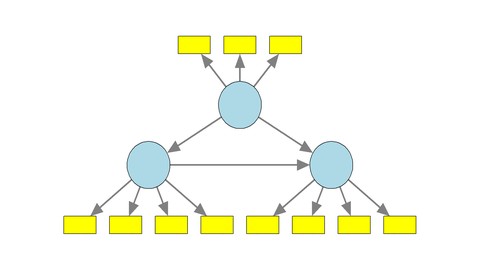
Conceptual Foundations of PLS Path Modeling
Conceptual Foundations of PLS Path Modeling, available at Free, has an average rating of 4.8, with 90 lectures, based on 384 reviews, and has 11211 subscribers.
You will learn about Understand the critical conceptual foundations of PLS path modeling. Understand exactly how the PLS path modeling algorithm calculates or "works." Understand how the bootstrapping and jackknifing resampling procedures "work" to determine significance levels. Know how to estimate, and the meaning of: direct, indirect, total, mediating and moderating effects. Understand the distinctions between formative and reflective constructs. Know how to assess the reliability and validity of an estimated PLS path model. Know the differences between the outer measurement and the inner structural models. This course is ideal for individuals who are Graduate students, faculty, or practicing professionals who use PLS path modeling should take this course. or Anyone who wishes to learn more about PLS path modeling will benefit from taking this course. It is particularly useful for Graduate students, faculty, or practicing professionals who use PLS path modeling should take this course. or Anyone who wishes to learn more about PLS path modeling will benefit from taking this course.
Enroll now: Conceptual Foundations of PLS Path Modeling
Summary
Title: Conceptual Foundations of PLS Path Modeling
Price: Free
Average Rating: 4.8
Number of Lectures: 90
Number of Published Lectures: 90
Number of Curriculum Items: 90
Number of Published Curriculum Objects: 90
Original Price: Free
Quality Status: approved
Status: Live
What You Will Learn
- Understand the critical conceptual foundations of PLS path modeling.
- Understand exactly how the PLS path modeling algorithm calculates or "works."
- Understand how the bootstrapping and jackknifing resampling procedures "work" to determine significance levels.
- Know how to estimate, and the meaning of: direct, indirect, total, mediating and moderating effects.
- Understand the distinctions between formative and reflective constructs.
- Know how to assess the reliability and validity of an estimated PLS path model.
- Know the differences between the outer measurement and the inner structural models.
Who Should Attend
- Graduate students, faculty, or practicing professionals who use PLS path modeling should take this course.
- Anyone who wishes to learn more about PLS path modeling will benefit from taking this course.
Target Audiences
- Graduate students, faculty, or practicing professionals who use PLS path modeling should take this course.
- Anyone who wishes to learn more about PLS path modeling will benefit from taking this course.
Conceptual Foundations of PLS Path Modelingprovides a comprehensive introduction to the most critical foundational concepts of PLS path modeling. Virtually the entire course consists of narrative lectures accompanied by powerpoint slides and some readings.The course does not teach how to use any particular specific PLS software modeling package. The course is very useful as a preliminary course to any other “hands-on” course that teaches how to use specific PLS path modeling (or related) software (such as SmartPLS 2.0 or 3.0; WarpPLS; the semPLS or plspm packages in R; ADANCO; pls-gui.com; and so on). Participants learn the conceptual basics of the following critical path modeling terms and processes: What is PLS path modeling?, formative versus reflective constructs, assessing reliability and validity, bootstrapping and blindfolding, how to estimate direct, indirect, total, mediating and moderating effects.
This course is intended for graduate students, faculty and other researchers who seek explicit and comprehensive explanations and of the foundational concepts that underlie PLS path modeling. It addresses basic issues such as: How does the PLS algorithm ‘work’? What are the differences between the outer measurement and inner structural models in a path model with latent variables? What are the fundamental distinctions between formative and reflective constructs? What can one determine about direct, indirect, and total effects? About mediating and moderating effects? What do path coefficients, weights and loadings tell you about the underlying data relationships? What are latent variable ‘scores’ or values? What do the predictive levels of variance explained in the endogenous latent variables actually mean?
Course Curriculum
Chapter 1: Introduction to Course and Materials
Lecture 1: Introduction to Course
Lecture 2: A Word about the Course and the Materials
Chapter 2: Conceptual Basis for using PLS Path Modeling
Lecture 1: What is PLS Path Modeling ? (part 1)
Lecture 2: What is PLS Path Modeling ? (part 2)
Lecture 3: Motivations for Using PLS Path Modeling (part 1)
Lecture 4: Motivations for Using PLS Path Modeling (part 2)
Lecture 5: Motivations for Using PLS Path Modeling (part 3)
Lecture 6: Motivations for Using PLS Path Modeling (part 4)
Lecture 7: Motivations for Using PLS Path Modeling (part 5)
Lecture 8: Motivations for Using PLS Path Modeling (part 6)
Lecture 9: More notes on PLS Path Modeling (part 1)
Lecture 10: More Notes on PLS Path Modeling (part 2)
Lecture 11: Resampling: Bootstrapping, Jacknifing, etc. (part 1)
Lecture 12: Resampling: Bootstrapping, Jacknifing, etc. (part 2)
Lecture 13: Formative versus Reflective Constructs (part 1)
Lecture 14: Formative versus Reflective Constructs (part 2)
Lecture 15: Formative versus Reflective Constructs (part 3)
Lecture 16: Formative versus Reflective Constructs (part 4)
Lecture 17: Formative versus Reflective Constructs (part 5)
Lecture 18: Formative versus Reflective Constructs (part 6)
Lecture 19: Finish PLS Relationships
Chapter 3: Reliability and Validity Assessment
Lecture 1: Measurement Model Assessment (part 1)
Lecture 2: Measurement Model Assessment (part 2)
Lecture 3: Internal Consistency Reliability (part 1)
Lecture 4: Internal Consistency Reliability (part 2)
Lecture 5: Indicator Reliability (part 1)
Lecture 6: Indicator Reliability (part 2)
Lecture 7: Discriminant Validity
Lecture 8: Average Variance Extracted
Lecture 9: More on Discriminant Validity Measures
Lecture 10: Assessing Formative Indicators (part 1)
Lecture 11: Assessing Formative Indicators (part 2)
Lecture 12: Assessing Formative Indicators (part 3)
Lecture 13: Assessing Formative Indicators (part 4)
Lecture 14: Assessing Formative Indicators (part 5)
Chapter 4: What is Bootstrapping ?
Lecture 1: Bootstrapping (part 1)
Lecture 2: Bootstrapping (part 2)
Lecture 3: Bootstrapping (part 3)
Lecture 4: Bootstrapping Examples (part 4)
Lecture 5: Bootstrapping Examples (part 5)
Lecture 6: Bootstrapping Examples (part 6)
Lecture 7: Bootstrapping Concepts (part 7)
Lecture 8: Bootstrapping Examples (part 8)
Lecture 9: Bootstrapping Features (part 9)
Lecture 10: Bootstrapping Sign Changes (part 10)
Lecture 11: Bootstrapping Sign Changes (part 11)
Lecture 12: Bootstrapping Sign Changes (part 12)
Chapter 5: PLS Algorithm
Lecture 1: Introduction to PLS Algorithm
Lecture 2: PLS Algorithm Example Model
Lecture 3: PLS Algorithm
Lecture 4: PLS Algorithm Step 0: Initialization (part 1)
Lecture 5: PLS Algorithm Step 0: Initialization (part 2)
Lecture 6: PLS Algorithm Step 0: Initialization (part 3)
Lecture 7: PLS Algorithm Step 0: Initialization (part 4)
Lecture 8: PLS Algorithm Step 1: Inner Weights Estimation
Lecture 9: PLS Algorithm Step 2: Inside Approximation
Lecture 10: PLS Algorithm Step 3: Outer Weights Estimation
Lecture 11: PLS Algorithm Step 4: Outside Approximation
Lecture 12: PLS Algorithm: Stop Criterion Convergence
Lecture 13: PLS Algorithm: Final Parameters Estimation (part 1)
Lecture 14: PLS Algorithm: Final Parameters Estimation (part 2)
Lecture 15: PLS Algorithm Inner Weighting Schemes (part 1)
Lecture 16: PLS Algorithm Inner Weighting Schemes (part 2)
Chapter 6: Blindfolding
Lecture 1: What is Blindfolding ? (part 1)
Lecture 2: What is Blindfolding ? (part 2)
Lecture 3: What is Blindfolding ? (part 3)
Lecture 4: Calculating Q-Squared Predictive Relevance (part 1)
Lecture 5: Calculating Q-Squared Predictive Relevance (part 2)
Lecture 6: Calculating Q-Squared Effect Size
Chapter 7: Mediation
Lecture 1: Introduction to Mediation (part 1)
Lecture 2: Introduction to Mediation (part 2)
Lecture 3: Sobel and Testing for Mediation (part 1)
Lecture 4: Sobel, VAF, and Testing for Mediation (part 2)
Lecture 5: More Measures and Examples
Lecture 6: From Simple to More Complex Mediation
Lecture 7: More Complex Mediations
Lecture 8: Complex Mediation Example (part 1)
Lecture 9: Complex Mediation Example (part 2)
Lecture 10: Complex Mediation Example (part 3)
Lecture 11: Complex Mediation Example (part 4)
Lecture 12: Complex Mediation Example (part 5)
Lecture 13: Complex Mediation Example (part 6)
Lecture 14: Complex Mediation Example (part 7)
Lecture 15: Complex Mediation Example (part 8)
Chapter 8: Moderation
Lecture 1: Moderation Concepts Introduction (part 1)
Lecture 2: Moderation Concepts Introduction (part 2)
Lecture 3: Product Indicator Example (part 1)
Lecture 4: Product Indicator (part 2)
Lecture 5: Two-Stage Approach
Lecture 6: Group Differences Approach
Instructors
-
Geoffrey Hubona, Ph.D.
Associate Professor of MIS and Data Analytics
Rating Distribution
- 1 stars: 3 votes
- 2 stars: 9 votes
- 3 stars: 41 votes
- 4 stars: 154 votes
- 5 stars: 177 votes
Frequently Asked Questions
How long do I have access to the course materials?
You can view and review the lecture materials indefinitely, like an on-demand channel.
Can I take my courses with me wherever I go?
Definitely! If you have an internet connection, courses on Udemy are available on any device at any time. If you don’t have an internet connection, some instructors also let their students download course lectures. That’s up to the instructor though, so make sure you get on their good side!
You may also like
- Best Investing Courses to Learn in March 2025
- Best Personal Finance Courses to Learn in March 2025
- Best Health And Wellness Courses to Learn in March 2025
- Best Chatgpt And Ai Tools Courses to Learn in March 2025
- Best Virtual Reality Courses to Learn in March 2025
- Best Augmented Reality Courses to Learn in March 2025
- Best Blockchain Development Courses to Learn in March 2025
- Best Unity Game Development Courses to Learn in March 2025
- Best Artificial Intelligence Courses to Learn in March 2025
- Best Flutter Development Courses to Learn in March 2025
- Best Docker Kubernetes Courses to Learn in March 2025
- Best Business Analytics Courses to Learn in March 2025
- Best Excel Vba Courses to Learn in March 2025
- Best Devops Courses to Learn in March 2025
- Best Angular Courses to Learn in March 2025
- Best Node Js Development Courses to Learn in March 2025
- Best React Js Courses to Learn in March 2025
- Best Cyber Security Courses to Learn in March 2025
- Best Machine Learning Courses to Learn in March 2025
- Best Ethical Hacking Courses to Learn in March 2025






















